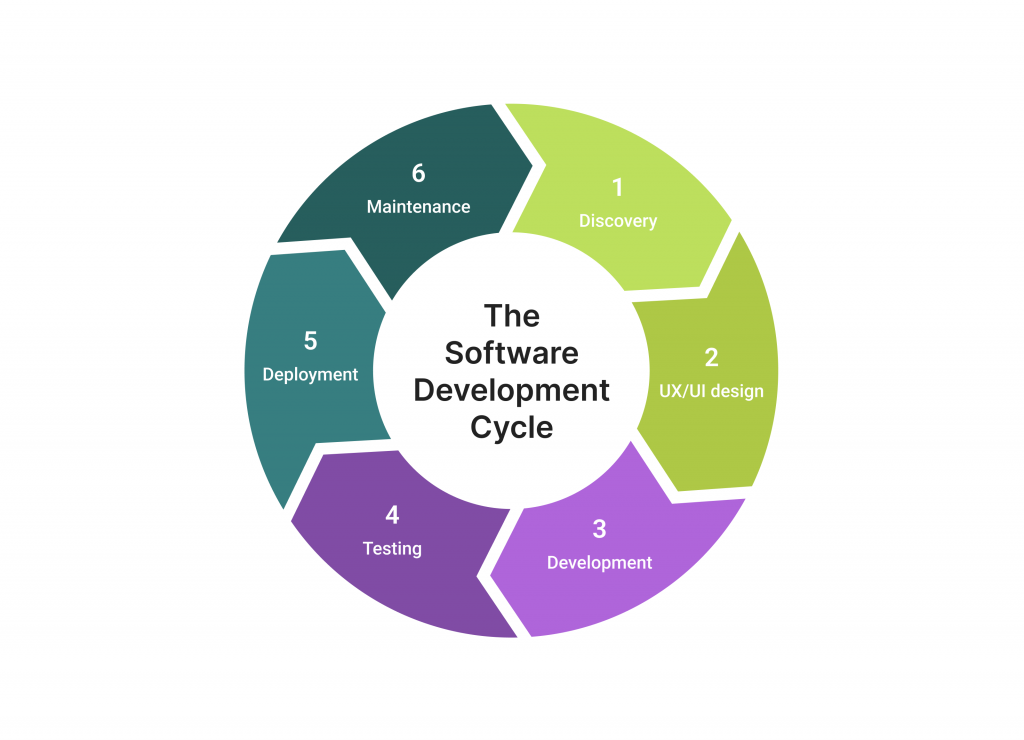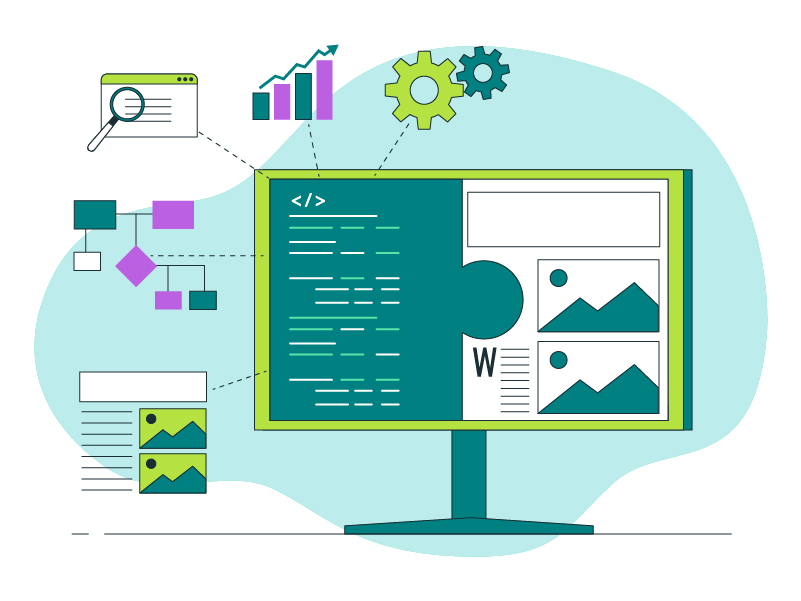Want to learn about SDLC phases?
The software development life cycle (SDLC) consists of six basic phases: discovery, design, development, testing, deployment, and maintenance. Each phase is designed to help design software according to your needs.
But the benefits of following SDLC phases don’t end there. Thanks to SDLC, companies reduce project costs, maximize value for users, and catch problems before they affect the progress.
What you’ll learn in this guide:
- SDLC definition
- Main stages of SDLC
- Benefits of SDLC for Startups
What is the Software Development Life Cycle (SDLC)?
Software development life cycle (SDLC) is a structured process that involves steps necessary to build a software application in a cost-effective way. SDLC gives businesses a step-by-step, systematic approach to creating software from as early as planning.
The nature and number of stages in SDLC vary from model to model. The six-stage SDLC model we illustrate below is the most straightforward. It includes six stages: discovery, design, development, testing, deployment, and maintenance.

As you can see—
The phases of SDLC essentially make it a project management model. Everything starts with the initial idea and planning and ends with the maintenance of the completed product.
Next, let’s go over each stage of SDLC and break down everything you need to know.
Software Development Phases
Learning about the stages of SDLC is important for clients of software development companies. If you have the basic knowledge of software lifecycle phases, you know what happens at each stage, who’s involved, what their roles are, and how to move forward faster.
So, let’s look at each SDLC stage. You’ll learn what they mean, what is done, and who is involved.
Phase I. Discovery (Planning)
Even if you have a detailed plan for your software idea, chances are there are still plenty of uncovered risks and issues. That’s totally okay—software development for business is a complex process where one detail can change everything.
This is why we have the discovery stage. It’s often called the “planning” stage because the team responsible for project completion will collect and decide on the requirements for the future software. By doing so, they will clearly define what the client wants to achieve.
Here’s what happens during discovery:
- Free consultation. The client gets their software idea and goals analyzed by the software vendor. Once everything is covered, the vendor makes a preliminary estimate for the entire project.
- Analysis of client materials. In many cases, clients have lots of documentation, legacy code, or other extra info that could help the vendor to understand their goals better. Analyzing everything is the priority at this step.
- Workshop with the software team. The client and the team join forces to plan the software release plan as well as the talent required to complete the project. Also, they work on software requirements, design, and use cases.
- Prototyping (proof of concept). This step involves creating a prototype of the future product with very limited functionality to prove the technical feasibility of the project. Also, the prototype is useful to get an idea of the product’s look and “feel.”
- Final project planning. The team summarizes all the findings and materials from the previous steps to create the final planning document. It includes plans to manage costs, timelines, resources, and risks. Once the client approves the doc, the project can start.
These steps sound like a lot of work, right?
Yet, the discovery stage is essential to project success. Even the most detailed software project plan might not be enough without a diligent, detailed, and thorough analysis.
If you want to learn more about the discovery stage, read this in-depth guide: Discovery Stage in SDLC: Importance, Steps, Tips.
Phase II. Design
At this point, the team has defined the broad requirements and goals for the project. Next, they move on to the design phase of SDLC, whose goal is to define how to actually build the product. In other words, we’re getting specific and creating detailed instructions.
Although clients are actively involved in this SDLC phase (as in every other one), most of the work is done by the software team.
Using the docs prepared earlier, the team delivers:
- Product visualizations. Called UI design review, the goal of this process is to define the appearance of the future project.
- Technical designs and standards. Coding standards, descriptions of tasks for developers along with timelines—these are prepared to ensure the team has a plan to implement the design with technical means.
- Quality verification and validation. A quality assurance (QA) team steps in to test the designs to detect issues like bugs and inconsistencies.
Once the team delivers everything—and the top management gives the green light—the actual development of the product can start.
If you’d like more details about what happens at this stage, this guide to SDLC Design Phase: Definition, Activities, Goals is what you’re looking for.
Next, we’re moving on to the development.
Phase III. Development
Now, software developers get down to writing the code for the product. They rely on the previously defined requirements and plans to guide their work. Among all SDLC phases, this one is the longest.
The coding process is complex and includes many other tasks. Besides the actual coding, developers need to ensure compatibility of features, consistency of the code, and a lack of errors and glitches.
As a client, you also have some work to do.
Your project manager will encourage you to participate in daily and/or weekly meetings of developers. This way, you can get updates on the project, help using your business expertise, and stay in touch with developers.
Speaking of developers…
Our post Software Developers: Who They Are & What They Do answers the most common questions clients have about developers.
Phase IV. Testing
The code for the software is built.
Now, it needs to be tested to eliminate bugs and errors that affect user experience. This is where QA engineers come in. Their job is simple: ensure that the final product works properly by finding issues.
Here’s how QA engineers do their job:
- Test plan creation. The plan includes instructions for testing, test types, ways the software will be tested, and resources for testing.
- Testing. Engineers run tests according to the plan to detect software issues such as bugs and design inconsistencies.
- Reporting. Test results are reported to software developers along with recommendations to fix them.
The duration of testing varies and depends on product complexity. But one thing is certain: testing continues until the software is bug-free, stable, and works as intended.
Bugs can occur in software already used by clients, too. One common scenario is post-update, when an update causes some parts of the software to work incorrectly. Regression testing is required in this case.
More details: What is Regression Testing?
Phase V. Deployment
Now, it’s time for the software to reach the market, so developers release the product for clients to use. Deployment can be as simple as publishing an app on a Google Play Store or adding a link to a special page on a website.
This SDLC stage marks an important milestone in the project, obviously, so the team prepares for the product launch accordingly. For example, you’ll need to do some marketing to promote the new software and encourage people to use it.
Also, the team must be prepared to collect and study user feedback. Reviews from users might give ideas on how to improve the product or access the overall satisfaction.
Phase VI. Maintenance
Now we’re moving into maintenance mode.
Here’s what it means—
Developers begin working on issues reported by users to keep the product working properly. Those issues include bugs such as slow responses.
Also, the developers might need to develop new features, should the client request so. With time, updates can be required to keep the software relevant.
Important:
You might discover ways to improve your product after the deployment.
That’s totally fine because no product is perfect from the start. For example, when you finally get thousands of users, you will collect an appreciable amount of feedback. Only then you might be able to find ways to provide better value for users.
Benefits of SDLC for Startups
For a startup, following the six stages of the software development life cycle is the best approach to save costs, maximize productivity, and create high-quality software products.
Here are the advantages of SDLC for startups.
Clear goals
SDLC promotes planning, which helps define clear goals. The discovery and the design phases in particular are very goal-oriented and provide the team with data and info they need to make reasonable projections and goals.
The clarity in goals is essential for any software project. For example, goals allow the project manager to plan the workflow for developers and prioritize their time to ensure maximum efficiency and productivity.
Proper testing
Software testing is a huge part of SDLC. No software can be released until developers fix the problems found by the QA team. Thorough testing leads to fewer problems down the line when the software is made available for users.
The variety of tests is another important factor. The QA team can employ tests to check different parts of the software. For example, security testing checks the product for resistance to hacker attacks, viruses, and unauthorized access.
Find more info on testing: Types of Software Testing
Clear project structure
SDLC stages make software projects more organized by providing more clarity on when to move forward. For example, the deployment can’t be initiated if the testing stage hasn’t been completed.
This clear progression helps teams to stay focused on the tasks that matter the most. In turn, this approach helps complete all the software development stages faster.
Minimize HR-related risks
Extensive planning at the beginning of SDLC helps define how many developers, testers, and other specialists are needed to complete the project. So, the project manager can plan the human resources accordingly.
Documentation is another factor that helps. SDLC ensures that the team puts all requirements and standards in writing, so if someone leaves the project, a new member can just review them to get up to speed. This way, the team can keep the project going without slowdowns.
Many product improvement opportunities
Following the stages of software development ensures plenty of opportunities to iterate and improve the product. User research, surveys, interviews, and other information is collected and analyzed throughout projects to allow improvement.
Summary
SDLC can simplify and speed up even the longest and most complex software development projects. This approach helps to build software quickly and efficiently while covering all bases like user value and testing.
Having a professional software development partner makes all the difference for project success. At IDAP Group, we offer dedicated teams to build quality software for clients—drop us a line if you’re looking for such a partner.



